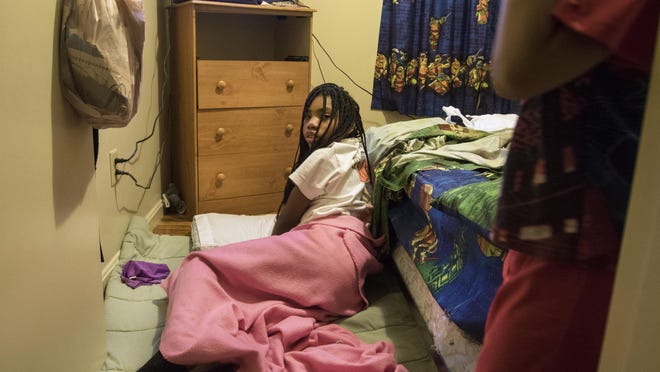

Can a COVID-19 relief program cut the number of Cincinnati area children in poverty in half? That would entail lopping the number of kids living in poverty from roughly 86,000 – or nearly the entire population of Campbell County – to about 43,000 (or approximately the population of Anderson Township).
New federal payments of $250 or $300 per child will begin to appear in parents' bank accounts and mailboxes this month, as an expanded child tax credit program gets underway July 15. The benefit is part of the American Rescue Plan, a response to the financial blow that the novel coronavirus pandemic dealt families and, in this case, children.
Experts say the benefit could cut the U.S. child poverty rate in half – a huge win for 25,000 children in Cincinnati, a city that's known for its high child poverty rate. And the benefit's impact won't stop there. Another 61,000 children in the 16-county region outside of the city live in poverty, according to U.S. Census Bureau estimates.
What isn't clear is whether the program and its expected impact will continue beyond a year or so.
Local children's advocates and service providers are welcoming the expanded child tax credit. They are optimistic about what the credit will do for the 1 in 6 kids in the Cincinnati region living in poverty. But some predict that it will take more than a one-year federal boost – and a diligent local commitment – to save the children here from the devastating impact of poverty.
"The country is providing what it should have provided before, as a part of the American way," said the Rev. Ennis Tait, pastor of New Beginnings Church of the Living God in Avondale, who was also a board of directors member of the former Cincinnati Child Poverty Collaborative. “We've got to keep working. We need grassroots initiatives to help lift people from poverty. We need to meet the basic needs of families."

What is this new credit?
The child tax credit for 2021 will give families $3,000 per qualifying child who is 6 to 17 years old. It will provide $3,600 for every qualifying child younger than age 6.
Who can get the benefit? It's available to parents who are single and earn under $75,000 a year, married couples who file jointly and earn annual income of less than $150,000, and single "head of household" filers who make less than $112,500 a year. Also, families who did not previously qualify for the refund because they had little or no tax obligation will now be able to receive it.
It's a benefit that is not only greater than previous tax credits but has greater reach – including families who are not working, have incomes too low to be required to file taxes, or who have not recently filed income tax forms with the Internal Revenue Service.
If you haven't filed a tax return to the IRS recently or don't work, you can go to the IRS.gov online Child Tax Credit non-filer sign-up tool to enroll. Unless parents opted out, the monthly payments of $250 or $300 per child will happen from July-December, and the second half will arrive in 2022 after parents file their tax 2021 tax returns.
Child tax credit: Families will start receiving monthly advance payments July 15
Temporary relief or long-term remedy?
Jaime Mutter, director of Every Child Succeeds at Santa Maria Community Services, which provides social services for residents in the Price Hill neighborhoods, worries that many children in the families she’s helped during the pandemic will reap no long-term relief from the benefit.
Mutter uses an East Price Hill mother with four children, ages 10, 5 and twins age 4, as an example. The twins are autistic. Mutter was a home visitor for the woman's children during the height of the pandemic in 2020.
“She was struggling before this,” Mutter said. During the pandemic, the woman’s troubles multiplied. “She was constantly losing jobs” because she had to care for her kids. The twins were kicked out of childcare settings for unpredictable behavior, Mutter said. The woman's other children had different school schedules, sometimes at home, sometimes in person, leaving their mother caring for them and missing work.
At the mother's request, Mutter did not provide names of the woman and her children for publication. She said the tax credit will provide immediate relief for the mom, but it will not pull the children from poverty.
“How she’s going to pay for her rent, her utilities?” Mutter said. “She’s depending on this money. She is behind.”
Dr. O’dell Owens, recently retired president and CEO of Interact for Health, a 20-county health equity nonprofit based in Kenwood, is more positive.
“Anytime you can put money into the pockets of parents you are always going to be better off,” Owens said. “Parents will make that investment for their children.”
The money will give families choices they did not have during the pandemic, Owens said. Some might provide an enhanced dinner, with a wide variety of foods, for their children. Others will pay for utilities, rent or children’s clothing, “especially shoes,” he said.
As for the future of the children, the tax credit will allow some parents to move their child to a qualified child care center, ensuring a good education start and possibly allowing moms the chance to return to work, he said.

Owens said the early, incremental payments from the IRS will help get children out of their pandemic poverty status and not spend all of the money at once.
Even if parents do not meet their financial goals for their children, Owens said, the benefit will reduce the stress in families. “And there’s a rippling effect of that: better mental health.”
Could tax credit go beyond 2021?
Owens and other children's advocates hope the benefit will be extended beyond one year.
It is an idea that U.S. Sen. Sherrod Brown, D-Ohio, is working to make happen. Brown was at the Greater Cincinnati Foundation on June 29 to hear what parents and children's advocates think of the expanded tax credit's likely impact.
Senior Social Equity Specialist Desiré Bennett, of Design Impact, a nonprofit social innovation firm in Madisonville, is among those who spoke. She serves on several boards in the community including the city's Gender Equality Taskforce, the Hamilton County Commission on Women and Girls, and the MLK Coalition.
"When I was a 19-year-old mom, there weren’t many opportunities to have advancement like this," she told Brown.

Jorge Perez, Greater Cincinnati YMCA president and CEO, was another roundtable guest.
About 65% of the children enrolled in Greater Cincinnati YMCA’s kids’ programs are on a form of financial assistance, records show. Perez is looking forward to their families getting the tax credit benefit.
“Will it financially assist families? Yes, it will,” Perez said in an interview. “Will it address long-term poverty? That remains to be seen.
“Until we provide ongoing resources to address systematic needs and provide equitable access in our educational systems, economic and social landscapes,” he said, “the roots of poverty will not be severed.”
Chipping away at child poverty
A local plan to end child poverty in Cincinnati was the goal of a Child Poverty Collaborative of Cincinnati, which started in 2016. The group of governmental, business and community stakeholders under Cincinnati Mayor John Cranley brought attention to the fact that the city's child poverty rate was among the highest in the nation. Cranley's vow before the collaborative started its work was to lift 10,000 children out of poverty within five years.
“It’s a bold, audacious goal,” the mayor said then. “But if we want to make a real historic difference, we have to set our sights on the notion that it’s morally unacceptable to have this many children in poverty.”
Sister Sally Duffy, a Sister of Charity who was among the collaborative's board members and continues to advocate for children, said the group spurred a movement that continues today. "We were on the right pathway," she said.
In February, the Child Poverty Collaborative of Cincinnati announced it had turned over its Project Lift, a public-private partnership designed to lift families from poverty, to the United Way of Greater Cincinnati. More than 20 agencies sponsor the project.

“The emphasis shifted on how to help families out of poverty. Once we brought families into the equation it changed how we approached this,” Tait said. It made sense to move Project Lift to the United Way of Greater Cincinnati, which already reached out to adults and families, and have workforce efforts continue for families under the Cincinnati USA Regional Chamber.
“The work of the CPC wasn’t going to be able to manifest without pulling in corporations, organizations and agencies that were touching people on the adult level,” Tait said.
More than 1,000 families have been enrolled since Project Lift since its inception in the spring of 2019, United Way records show.
Families with Project Lift work with sponsoring agencies they trust to get critical, short-term assistance, United Way of Greater Cincinnati President and CEO Moira Weir said. The idea is that they will carve their own paths to long-term success while growing a shared support system that helps them thrive.
Tait said it's up to trusted "nontraditional partners, deeply embedded in our community" – including himself as a faith-based leader in Avondale – to connect families with the best resources that the region has or needs to create. “Our challenge going forward, we’re going to have to trust the communities to help themselves find creative ways to put resources in the hands of the community," he said.
Weir said her agency and Project Lift's sponsoring partners are committed to reaching more families and finding ways to knock down barriers that impoverished families face.
Weir spoke highly of the 2021 expanded child tax credit.
"Prior to the pandemic, 1 in 4 families in Greater Cincinnati faced financial insecurity," she said. "The pandemic worsened the situation, and it hit hardest those who could least afford it – people earning lower salaries and people of color."
She pointed to the expectations that the federal boost to families with children will cut child poverty in half, saying, "If those numbers hold true, in Cincinnati alone, the child poverty rate would drop from 40% to near 20%.
"That is amazing," Weir said, "and we hope that comes true."
USA TODAY contributed.
Source link






